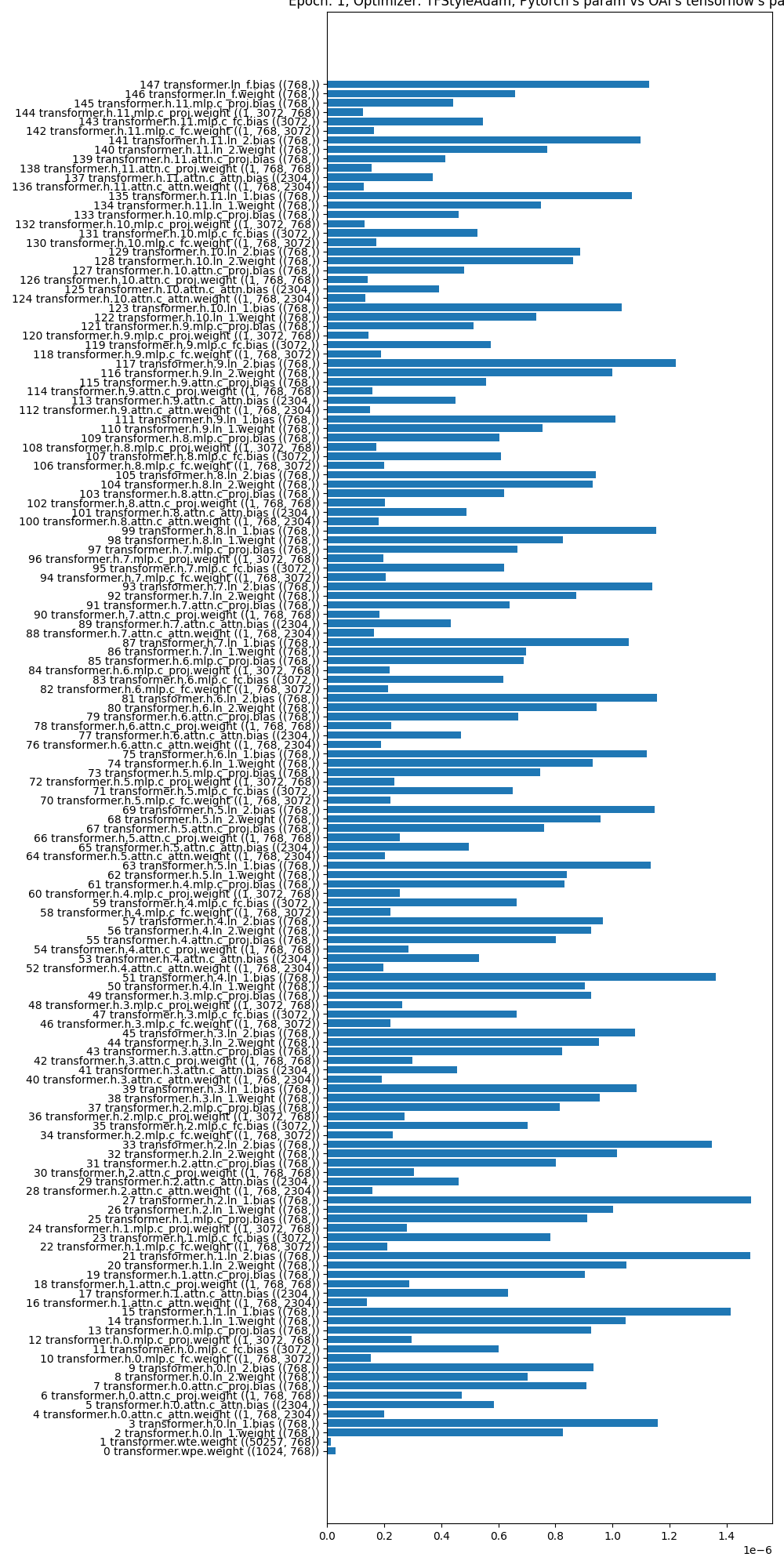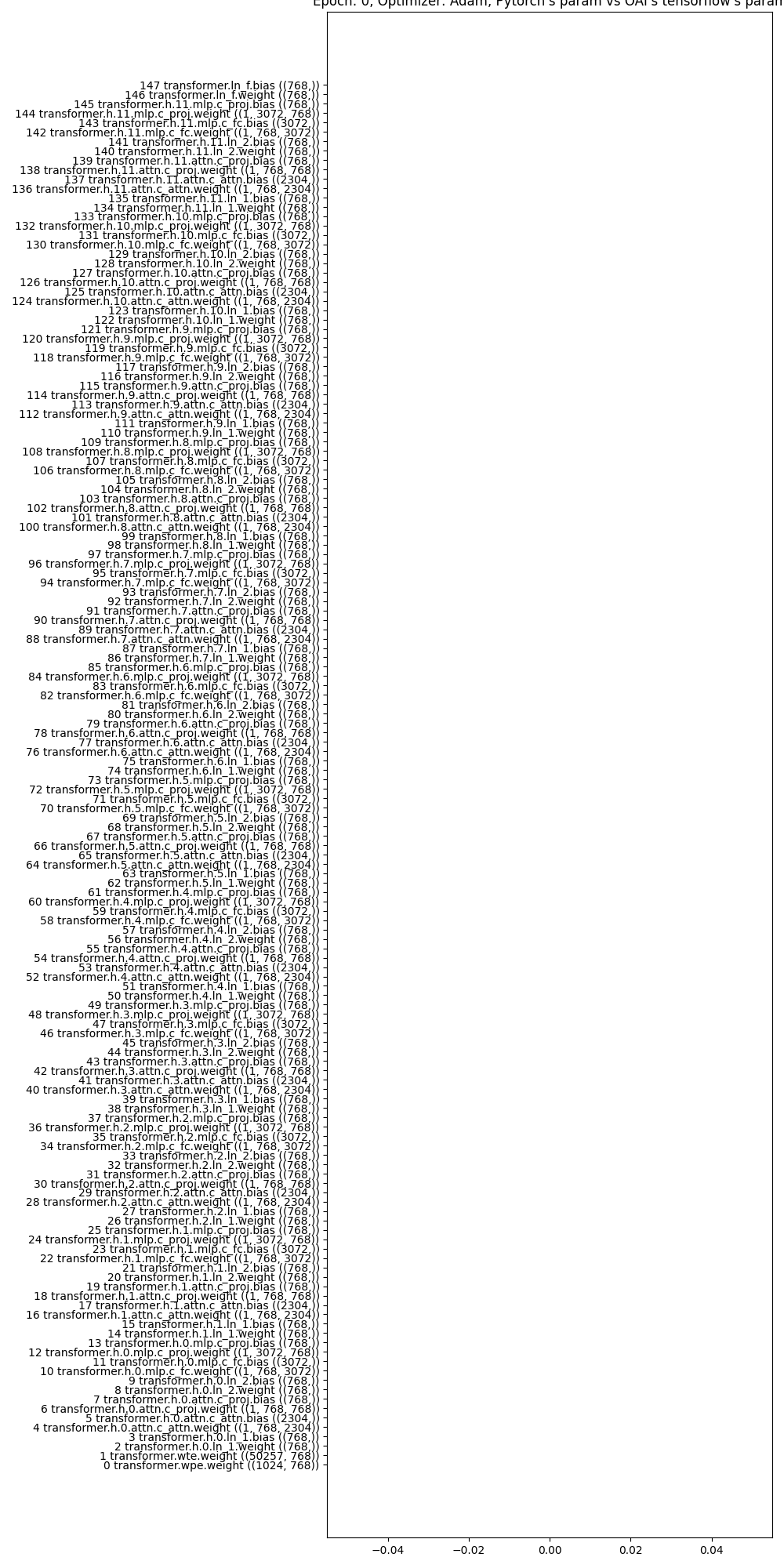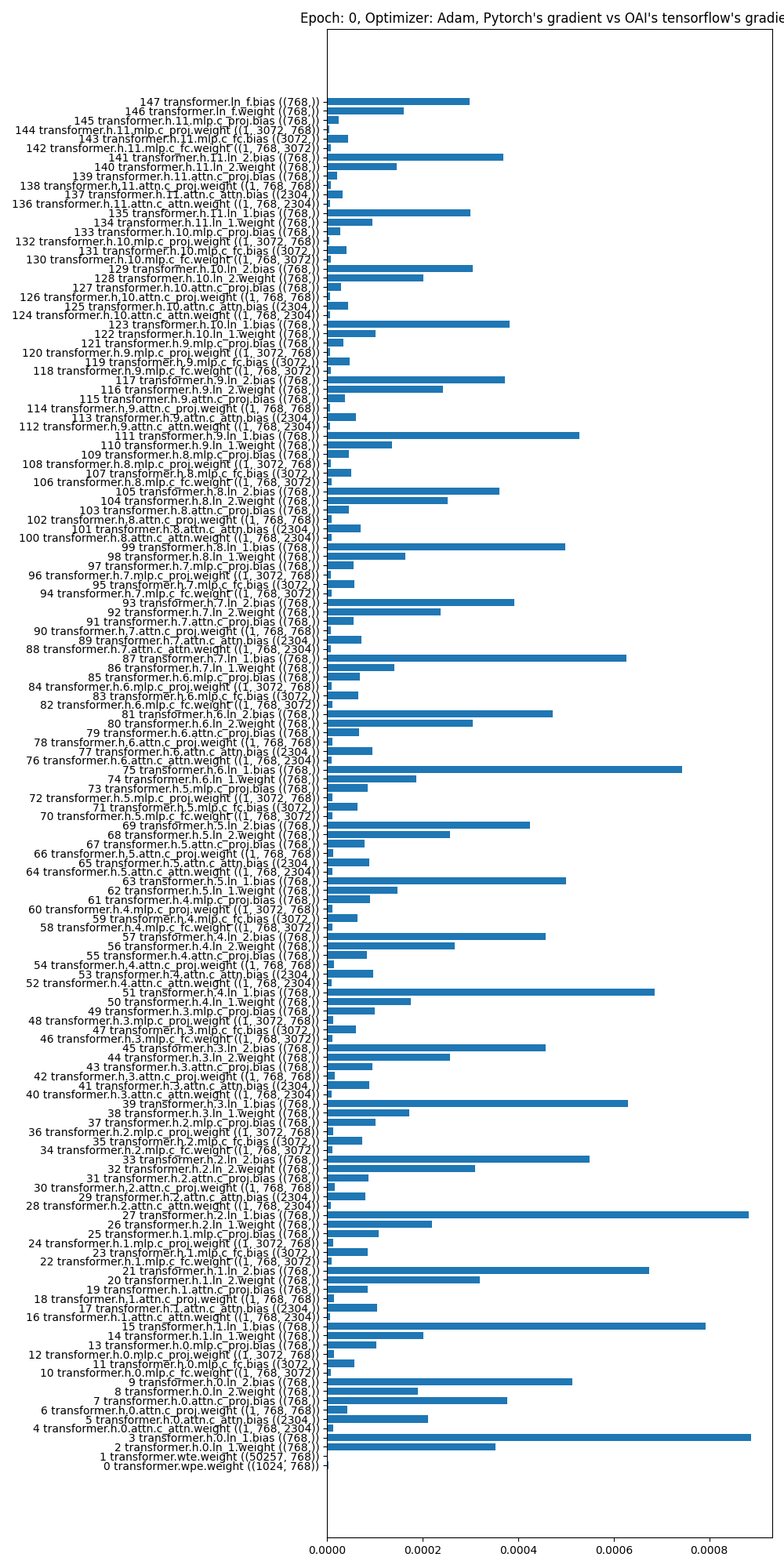This is a minimal repro for early aggresive updates in PyTorch Adam when doing PPO + RLHF.
TL;DR. PyTorch Adam causes an aggresive initial policy update.
I record the original query, response, and rewards from https://github.com/openai/lm-human-preferences and save them in https://huggingface.co/datasets/vwxyzjn/lm-human-preferences-debug/tree/main . I also record the weights and gradeint of the first two epochs of training with Adam and optimizers.
Here is a table summarizing the files and their contents:
| File | Contents |
|---|---|
query.npy |
The original query (batch of 64) |
response.npy |
The original response (batch of 64) |
rewards.npy |
The original rewards (batch of 64) |
params_and_grads.pkl |
The params and grads of the first two epochs of training with tf.train.AdamOptimizer(learning_rate=0.00001, epsilon=1e-5) |
poetry install
poetry run python main.py
It should output something like below.
==================================================
working with Adam: Adam with eps=1e-5
epoch=0, logprobs_diff mean=0.0
epoch=0, logprobs_diff var=0.0
epoch=0, logprobs_diff max=0.0
epoch=0, logprobs_diff min=0.0
epoch=0, ratio mean=1.0
epoch=0, ratio var=0.0
epoch=0, ratio max=1.0
epoch=0, ratio min=1.0
approxkl 0.0 pg_loss 1.2417634032146907e-08 pg_clipfrac 0.0
epoch=1, logprobs_diff mean=0.008101251907646656
epoch=1, logprobs_diff var=0.004668936599045992
epoch=1, logprobs_diff max=0.594489574432373
epoch=1, logprobs_diff min=-0.9134478569030762
epoch=1, ratio mean=1.0105520486831665
epoch=1, ratio var=0.005374275613576174
epoch=1, ratio max=1.8121057748794556
epoch=1, ratio min=0.4011387825012207
approxkl 0.0023672834504395723 pg_loss -0.034187596291303635 pg_clipfrac 0.02018229104578495
==================================================
working with TFStyleAdam: Tensorflow-style Adam with eps=1e-5
epoch=0, logprobs_diff mean=0.0
epoch=0, logprobs_diff var=0.0
epoch=0, logprobs_diff max=0.0
epoch=0, logprobs_diff min=0.0
epoch=0, ratio mean=1.0
epoch=0, ratio var=0.0
epoch=0, ratio max=1.0
epoch=0, ratio min=1.0
approxkl 0.0 pg_loss 1.2417634032146907e-08 pg_clipfrac 0.0
epoch=1, logprobs_diff mean=0.004073789343237877
epoch=1, logprobs_diff var=0.0007334011606872082
epoch=1, logprobs_diff max=0.22331619262695312
epoch=1, logprobs_diff min=-0.31471776962280273
epoch=1, ratio mean=1.0044583082199097
epoch=1, ratio var=0.0007942612282931805
epoch=1, ratio max=1.250215768814087
epoch=1, ratio min=0.7299948930740356
approxkl 0.000374998344341293 pg_loss -0.014567638747394085 pg_clipfrac 0.0052083334885537624
Observation 1: The ratio of the TFStyleAdam updates have significantly smaller variance than those of the Adam updates. Also, this result in a much smaller approxkl and pg_loss and clipfrac for SGD than Adam.
What's going on? I plot the parameter difference between main.py and lm-human-preferences before the training, which shows the parameters are identical.
After the first epoch of update, I then plot the gradient difference between main.py and lm-human-preferences:
Observation 2: Notice how the gradients of the LayerNorm parameters are significantly different. This is the root cause of the problem.
As an example, we print some gradients below. Notice how the first gradient for h0/ln_1/b:0 is 2.4899011e-05 in OAI's codebase, but 1.8152525e-05 in main.py. This is a difference of 0.6746486e-05, which is quite significant.
In comparison, the gradients of the other layers are much more similar. For example, the first gradient for h0/attn/c_attn/w:0 is 2.88992633e-05 in OAI's codebase, but 2.88992633e-05 in main.py. This is a difference of 0.0, which is much smaller than the difference in the LayerNorm parameters.
(Pdb) oname, ograd[:10], name, param.grad.detach().numpy()[:10]
('policy/model/h0/ln_1/b:0', array([ 2.4899011e-05, -1.1588502e-03, 1.7985557e-03, 7.4343453e-03,
-2.5840786e-03, -3.5906259e-03, -6.6465489e-04, 1.8007826e-03,
-1.6414827e-03, -6.6386913e-03], dtype=float32), 'transformer.h.0.ln_1.bias', array([ 1.8152525e-05, -1.1576341e-03, 1.7961735e-03, 7.4219629e-03,
-2.5832835e-03, -3.5855419e-03, -6.7265466e-04, 1.8039590e-03,
-1.6386800e-03, -6.6277790e-03], dtype=float32))
(Pdb) oname, ograd[:10], name, param.grad.detach().numpy()[:10]
('policy/model/h0/attn/c_attn/w:0', array([[[ 2.88992633e-05, -6.70402551e-06, -1.57610848e-05, ...,
-1.05873929e-04, -9.40704340e-05, 1.00523466e-04],
[ 7.87996178e-05, -5.04239551e-07, -8.35032733e-06, ...,
-4.07231477e-04, 4.93751504e-05, -2.81412737e-04],
[ 8.21374197e-05, -1.94475469e-05, -1.36382323e-05, ...,
-1.95847577e-04, -4.09606873e-04, 2.84076581e-04],
...,
[-6.02674390e-06, 4.23970641e-06, -7.39748998e-07, ...,
1.90844381e-04, -8.59782376e-05, -6.60822116e-05],
[ 3.50006849e-05, -1.32066066e-06, -3.52823263e-05, ...,
-1.33828435e-04, 1.01715421e-04, 3.40739585e-04],
[ 1.05423496e-04, -2.66656862e-05, -4.54609835e-05, ...,
-4.23200603e-04, -1.64171652e-04, 2.63288792e-04]]],
dtype=float32), 'transformer.h.0.attn.c_attn.weight', array([[ 2.88245592e-05, -6.68141320e-06, -1.57281083e-05, ...,
-1.05716754e-04, -9.39845631e-05, 1.00422243e-04],
[ 7.86117525e-05, -4.96559778e-07, -8.27262829e-06, ...,
-4.06837964e-04, 4.93464249e-05, -2.81286135e-04],
[ 8.19143170e-05, -1.94303120e-05, -1.35097052e-05, ...,
-1.95316272e-04, -4.09374770e-04, 2.83872039e-04],
...,
[-1.33238527e-05, -6.14432452e-08, 7.30297143e-06, ...,
8.94646073e-05, -1.24311875e-04, 1.05930310e-04],
[-1.15070456e-04, 1.79788076e-05, 3.04212826e-05, ...,
6.06048678e-04, 3.23058601e-04, -4.77053138e-04],
[-5.75132690e-05, 2.93947778e-05, 3.10599062e-05, ...,
2.26184493e-05, 1.36010476e-05, 9.29407452e-06]], dtype=float32))
Then after a gradient pass (i.e., optimizer.step()) in main.py, I plot the parameter difference between main.py and lm-human-preferences:
Observation 3: Even though the gradient of most layers are similar between pytorch and OAI's codebase, the Adam optimizer causes a significant difference in the parameters. For example, ('transformer.wte.weight', 'policy/model/wte:0') have near identical gradients as indicated in the last section, but their weights become quite different after a gradient pass.
In comparison, with TFStyleAdam, the parameters are much more similar between main.py and lm-human-preferences:
 . Note the scale of the x-axis is 4x smaller than that of
. Note the scale of the x-axis is 4x smaller than that of Adam.


